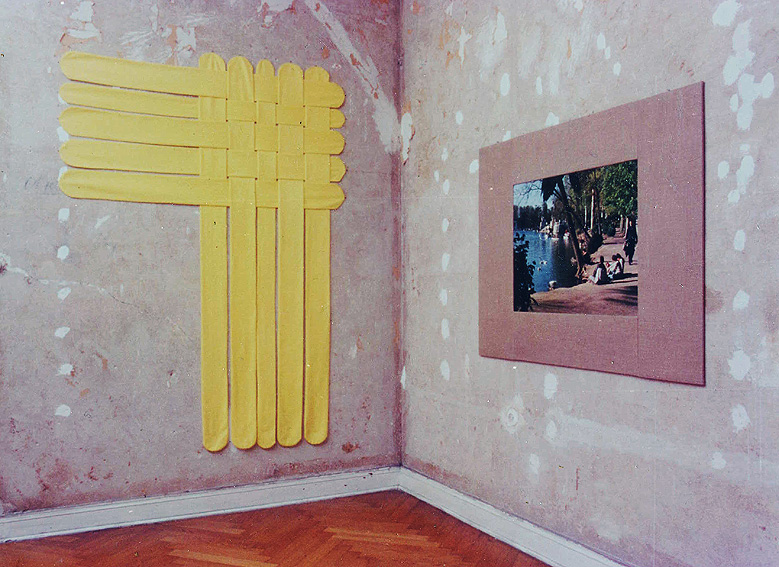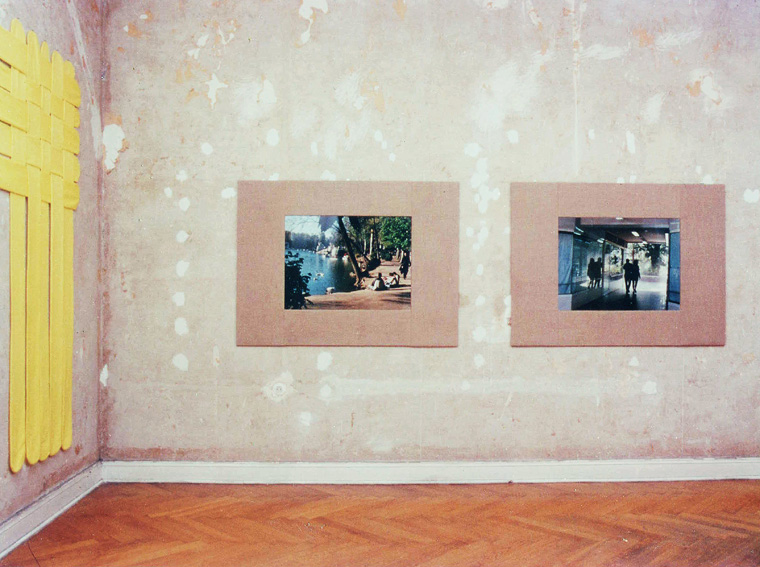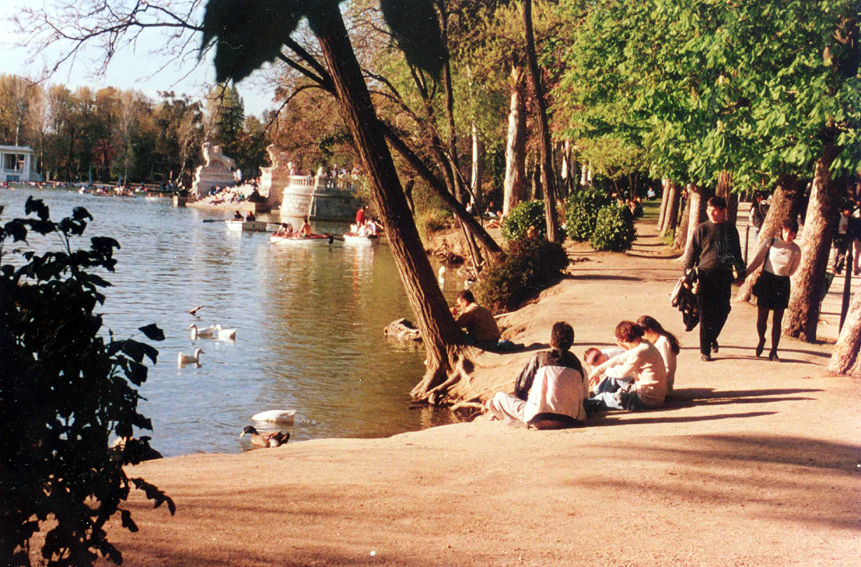45 Minuten später, 1995
This group show was curated by Lukas Duwenhögger, a painter that had in many senses a lot of importance for me. It included work by him, Ull Hohn, Janet Burchill and Jennifer McCamley, Martine Maffetti and me.
I showed a large object / painting, Rosette, that was based on an ornament, an inlay into one of the marble floors of the Palacio Real in Madrid. This ornament, which I had photographed while standing in front of it and therefore had a distorted perspective, was transferred onto wood and cut out, so it could be hung flat onto a wall. Finally I painted it with oil colors and it became a painting – abstract and photorealist at the same time. Abstract in the sense that the floor makers had already abstracted it from the natural forms of a flower.
It was complemented by Webstück, a soft version of a very simple constructivist idea, executed in yellow felt.
Parco del Buen Retiro and Centro comercialy Cultural de Atocha were both c-prints mounted on board, framed with very large frames covered with jute. For me the jute had connotations both to raw canvas (to paint on) and the materials that were used as the background for 1970s museum display cases.
This is the text I wrote for the show:
“My room in the group show 45 Minuten später, which is meant to be a collaboration on the thematic of the city, circles the themes of freedom and functionality.
The Arcadia that is possible today is a small escape on Sundays, the forgetting of one’s identity for a moment. This identity is constituted by the entanglements of work, living space, relationships in the city – and this purposefulness of the way people relate to each other and to their surroundings can only be bridged, not be wiped out or forgotten. In our secular European culture, the trigger for this gap or absent-mindedness is supposed to be nature or art – art in the sense of the meaning it has for the masses that fill the big museums on Sundays, of the relevant recipients, not the specialized circle of the art world.
It is here that the theories of Kant and Adorno live on, who thought that art and nature could pull human beings out of their being defined by purposes (Zweckgebundenheit). Kant thought that they could make them become aware of their “higher end” (höherer Zweck).This longing for either absent-mindedness or higher end, that no doubt exists, remains without aims; an escape out of the narrow frame of the given, in which one is functioning and seen as worker, mother, shopper etc.
The free, abstract ornament was for Kant the prime example of beauty, even if it was put to use as a decorative element, as the original for Rosette was on a marble floor. It was beauty for the same reasons the natural forms of a flower are perceived as being beautiful: the concentric, symmetric, harmonious ways the petals are arranged. “Reason” (Verstand) confirms to “Imaginativeness” (Einbildungskraft) that the useful in life is the same as the beautiful; an idea that culminates in the well arranged, beautiful as well as useful household in Adalbert Stifter’s Nachsommer.
Webstück (Weaving piece) refers to a different tradition of attempts to order the circumstances of people’s life in a way that is beautiful as well as useful: to Mondrian and his belief in happiness through perfect design.
The photos of Parco del Buen Retiro and Centro comercial y Cultural de Atocha show people in a thoughtfully designed park and in the passage of a commercial centre, which opens to a green house. The pictures allude to well-known images of our culture; the groups in the park are shepherds in Arcadia, the couple in front of the green house is Adam and Eve in Paradise. In reality they are normal people enjoying their weekend by fleeing into small artificial paradises; paradise and the Arcadian nature both stand for a friendly, tamed nature without dangers.
By showing these small freedoms I want to evoke the longing for a bigger one. Art, itself supposed to be an Ersatz paradise, remains in a reflexive distance to its function without rejecting it.”
Antje Majewski, 1995
Thank you:
Lukas Duwenhögger
Exhibition:
45 Minuten später, Wiensowski & Harbord, Berlin / 1995



